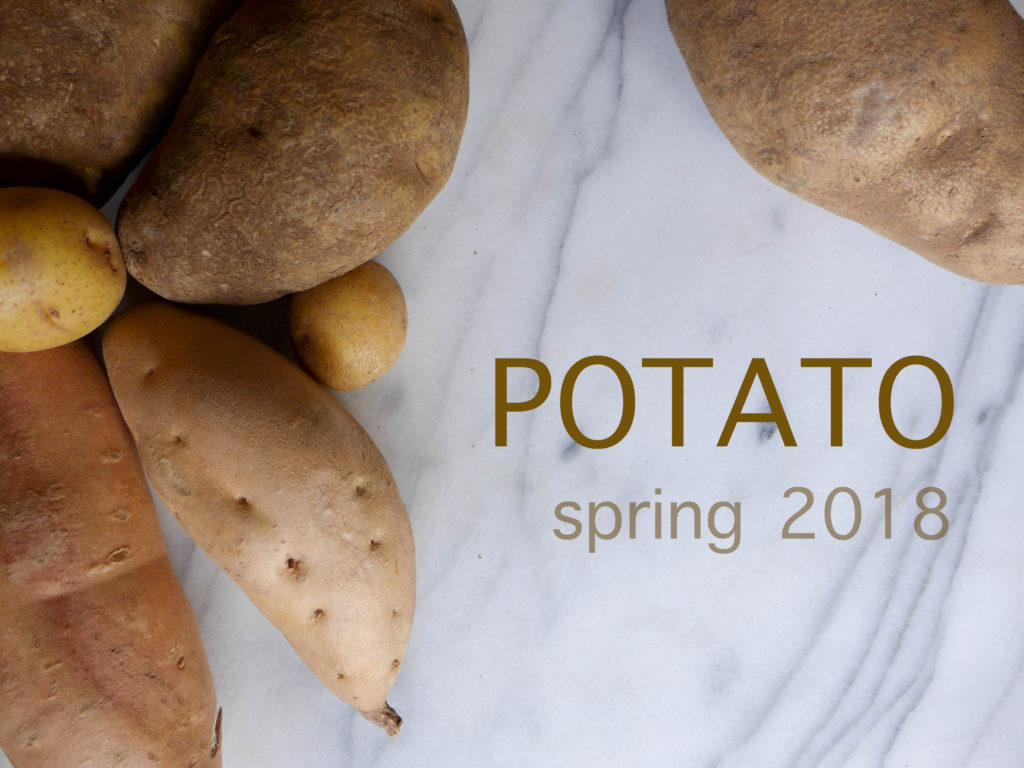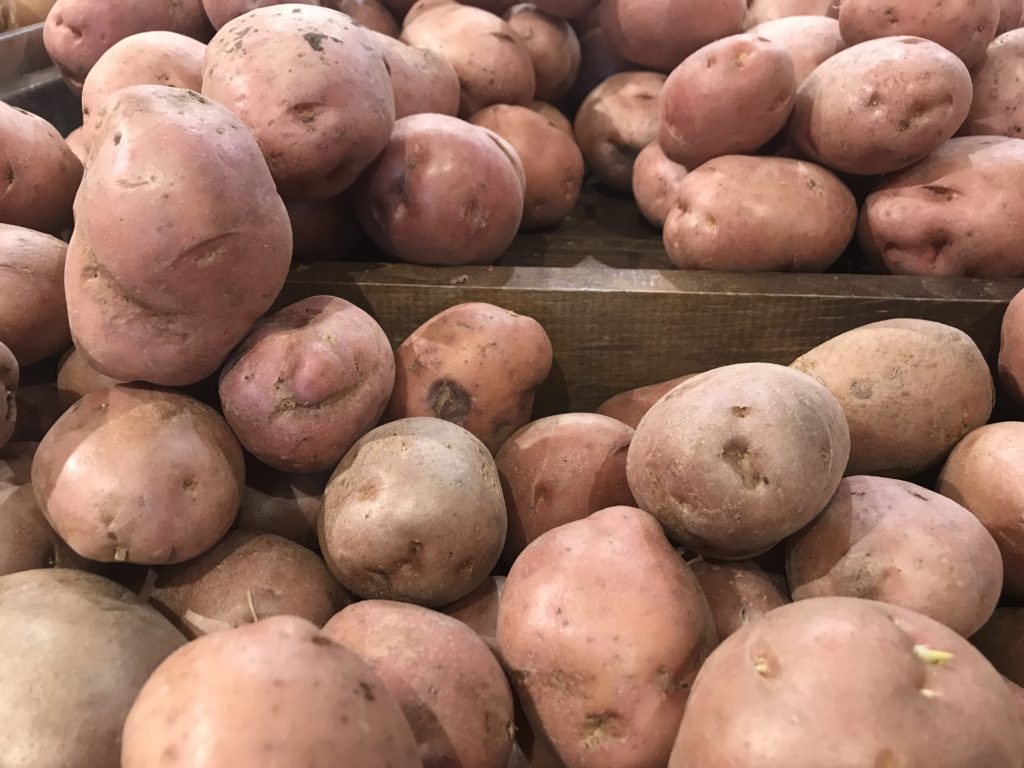Every season we like to feature a single ingredient and use it in a variety of ways throughout the house, from the food to beauty to art. You can see our full archive of featured ingredients here. And you can see some of our previous potato posts here.
Potato, patato. However you pronounce it, we’re excited to call this tuber our ingredient of the season. Ah the potato, always the side-dish, never the main dish.

We think this vegetable gets a bad rap as being full of carbs and too bland (without a boatload of salt and butter) to be the centerpiece of a meal. We’re hoping to change that this season with a line-up of simple but delicious meals. Just a little something to bring spuds into the limelight and inspire you to give them a second (or third!) look. We’re also hoping to entertain you by putting the potato to work in a few unexpected ways…
History
Potatoes are indigenous to the Andes mountains of South America. Specifically, they are believed to have originated in a region of southern Peru and northwest Bolivia about 10,000 to 7,000 years ago! BUT over 99% of the potatoes grown today are believed to come from central Chile.
Spanish explorers introduced potatoes to Europe in the 16th century, and from there, it spread to ports around the world. Soon after its introduction in Europe, the potato became a staple crop, and it’s believed to be responsible for European population growth, particularly the boom in the 1800s. In talking about the importance of the potato on Europe, here’s one description of it’s impact:
“For the first time in the history of western Europe, a definitive solution had been found to the food problem,” the Belgian historian Christian Vandenbroeke concluded in the 1970s. By the end of the 18th century, potatoes had become in much of Europe what they were in the Andes—a staple. Roughly 40 percent of the Irish ate no solid food other than potatoes; the figure was between 10 percent and 30 percent in the Netherlands, Belgium, Prussia and perhaps Poland. Routine famine almost disappeared in potato country, a 2,000-mile band that stretched from Ireland in the west to Russia’s Ural Mountains in the east. At long last, the continent could produce its own dinner. (read more)

Of course, then there was that Great Irish Famine. Limited genetic diversity in the potato crops growing at the time left them vulnerable to disease. A fungus attacked the crops and caused a disease called late blight. Late blight is still a common problem in Europe and North America, but organic and non-organic potato farms have a methods for trying to control a fungus outbreak.
Today, the potato is the 4th or 5th largest food crop behind corn, wheat, and rice (we think that its standing depends upon whether you include sugar cane as a food?). In the past few decades, the potato’s popularity in Asia has increased. And today, China is the largest producer of potatoes, growing a whopping 25% of the world’s crop! The US is in the 5th position, making up only 5% of global production. #losers
Biology
There are about 8-9 species of potatoes, and across those there are approximately 5000 (yes, thousand!) varieties of cultivated potatoes. There are an addition 200 and some wild species of potatoes.
Potato plants are a member of the nightshade family. Nightshade plants are known to be highly toxic, and this is true for potatoes too. The toxic glycoalkaloids are produced by the plants as a defense against predators (think insects or other herbivores that would try to eat the plant). In humans, these compounds can cause headaches, diarrhea, cramps, and even death, however, toxicity is very rare.
Glycoalkaloids levels are highest in the areas of the plant that are above ground and most vulnerable to predation (flowers, leaves, stems). The chemicals are in their lowest concentrations in the tuber that we would eat, but they will increase in concentration if the tuber is growing out of the soil and is exposed to sunlight. If the tuber has started to turn green, that’s a sure sign that it may have produced glycoalkaloids.
Wild potato varieties often contain toxic levels of glycoalkaloids; much higher than is measured in the domesticated vegetable. But this makes the wild varieties such a valuable natural resource. If domesticated varieties become vulnerable to a particular disease, then they can be cross-bred with while varieties in an effort to increase disease resistance in the cultivated crop. But whenever this work is done, the new offspring have to be tested for toxicity levels.

New potato plants can be grown from either seeds or from “seed potatoes”. The seeds come from the flowers of grown plants, but since they will have been pollinated, there is a genetic lottery at work. The new plant may not produce a potato just like the parent plant(s).
Only certain potatoes can be considered for “seed potatoes”. They have to be free of disease, and in the US this means that they were grown in an area of the country with winters cold enough to kill pests, but with summers warm and long enough to allow for healthy plant growth. The potatoes are cut so that an “eye” exists on each bit that is to be planted. A new sprout grows from that eye, and that plant will be a clone of the original, just ensuring consistency in the variety’s crop from one generation to the next.
That is just the start of the potato’s season, but I promise you that we’ll be back with another post covering the potato harvest! We just have to find the photos. Hold us to it.
Nutrition
As we mentioned above, potatoes get a bad wrap for being a carb powerhouse. Admittedly, they are. But did you know that one baked potato with the skin on has more potassium than a banana?! And then there’s yams, with almost twice as much potassium than a potato. Believe it.
Less than 4 grams of potato provides 24% of your vitamin C and 23% of vitamin B6. And beyond this, it contains notable amounts of the other B vitamins, and a number of minerals like iron, magnesium, and phosphorous.
Just eat one already!
Potato Facts
- Mister Potato Head was the first toy ever advertised on TV. As you can see, you had to supply your own potato!
- In India, potato skins and honey are used to treat skin burns. The potato skin is placed on the wound and protects it while healing. I’m assuming that this is similar to the use of fish skins to treat burns in Brazil?
- Unfortunately, potatoes are one of the more pesticide-laden crops. In a series of USDA and FDA tests performed between 2000 and 2008, 80% of the potatoes sampled contained pesticide residues, and while the residue levels were considered “low”, they were still the highest among the 50 vegetables that were tested.
- The nickname spud comes from the spade that was used to dig the holes to plant the potatoes.
- There was a time when hot potatoes were kept in a person’s pocket and used as a hand warmer.
- We don’t know much about how the game Hot Potato got started.
We gave you a very brief overview of this historically important crop. And we didn’t even touch upon the difference between potatoes, sweet potatoes, and yams. Let’s save that for another post.
If you’d like to learn more, this is a great read! And there’s always Wikipedia.
